Home
> Progressions
> I Variation
What we still need to look at is
how that major tonic can be enhanced/modified, just like we've done
with other chords in the scale.
So, we already know that the first chord in the scale is a major tonic chord and how this chord is important as the root (or "home") of a major key progression. But there are different types of major chord that can work with this position (similar to how there was with the IV major chord).
The idea is to experiment with these variations. Just as an artist might experiment with different textures and colours on the canvas.
Remember, chords are covered in their own section, so please make sure you've explored that section, but let's go through some examples now...
For example, here are two common major 7th forms, the first built on an E string root note, the second on the A string...
There's also the major 9th, which is an extention of the major 7th...
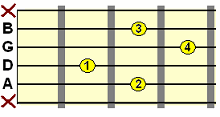
A typical blues progression would use the dominant 7th tonic chord. Again, the two most common forms...
You can also use a dominant 7th chord to "destabalise" the tonic before resolving to the IV chord. Here's an example...
Click to hear
You'll notice I also turned that major IV into a minor iv, which is one of the variations we looked at for the IV chord.
There are also extentions of these dominant 7th chords which are most commonly used in jazz and blues.
One of my favourites is the dominant 9th chord (e.g. C9)...
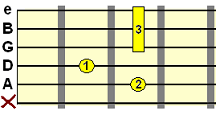
Or a 13th chord (e.g. C13) - a very "full" sounding chord (note: the fingering is a bit more awkward for this one, as you need to barre both your index and 4th finger)...
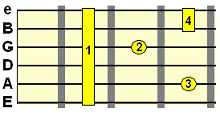
Remember, as these are dominant 7th chords, they can also be used in the V position, as we learned in past lessons that the 5 chord is naturally enhanced by using dominant 7th chords (hence why this 5th degree chord is called the dominant!).
More specifically on "jazzy" chords in another lesson.
A couple of A string root shapes...
Don't forget the open position added chords which can sound great as tonic chords.
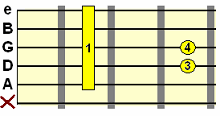
You could also use suspended 4th (sus4) chords in the tonic position, however, these chords perhaps sound too unresolved on their own and are most often resolved to a major chord in the same position, or at least interchanged with a regular major tonic, like below...
Click to hear
More on using the major tonic as an ending chord...
As a result, it's common to "big up" that final tonic chord by extending the major chord and perhaps playing it in a different way so it sounds more vibrant. One way to attain this is to use open chords (chords which use open strings) to give the song more of a grand and conclusive finish. Simply play around with the basic chord shapes you know and see if you can beef up that ending chord.
For example, a really lush open Eadd9 chord can be built simply by adding our 4th finger to the D string at the 4th fret...
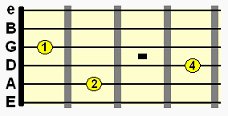
Listen to any classical or jazz piece and you'll hear how the ending tonic is milked for all its worth! This tradition carried right through into rock and pop, and for songs that don't simply fade out, the bigged up tonic is a popular choice for concluding the song.
However, there are also certain tensions you can add to that tonic chord to give it a more unorthodox, unpredictable or even unsettled conclusion to your song.
For example, this jazzy flat 5th chord provides us with a rather unsettling and confused ending...
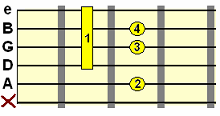
To me, that says "is this really the end...?"
Then there's the "big" blues ending, which uses the dominant 7th from earlier, but with an added #9, often referred to as the "Hendrix chord" because it was (apparently) popularised by Jimi Hendrix...
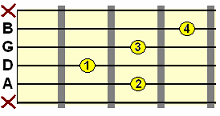
Here's the thing - from the past lessons on building the diatonic scale, you should know the root note positions. It's now up to you to experiment with the different chords you can build on these root notes. Explore the chord section for ideas.
Of course, sometimes simply using that basic major barre/open chord will worj well for your song, but having these creative options gives you the variation you need, from one song to the next.
Main Guitar Chord Progressions Section
Tonic Chord Variation
Over the past lessons you've seen examples of how the tonic in a major key progression (I) interacts with other chords in the scale and defines the key of the progression (e.g. A major, E major, C major etc.).
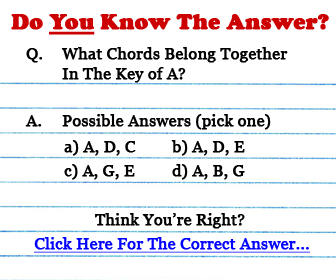 |
So, we already know that the first chord in the scale is a major tonic chord and how this chord is important as the root (or "home") of a major key progression. But there are different types of major chord that can work with this position (similar to how there was with the IV major chord).
The idea is to experiment with these variations. Just as an artist might experiment with different textures and colours on the canvas.
Remember, chords are covered in their own section, so please make sure you've explored that section, but let's go through some examples now...
Major 7th tonic (Imaj7)
Major 7th chords give your major tonic a relaxed and "safe" resolution. Without going too deeply into the theory behind it, the major 7th interval is seen as a "natural" extension of the major triad, because of the 7th's position in the major scale (which is what this chord scale is based upon).For example, here are two common major 7th forms, the first built on an E string root note, the second on the A string...
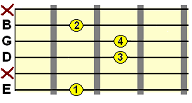 |
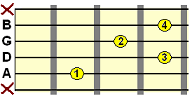 |
There's also the major 9th, which is an extention of the major 7th...

Dominant 7th tonic (I7)
The staple tonic in blues and jazz progressions. The dominant 7th chord (also used commonly in the IV and V positions as we learned previously), provides a more unstable tonic (i.e. it's not quite like home!), but with its own distinct flavour.A typical blues progression would use the dominant 7th tonic chord. Again, the two most common forms...
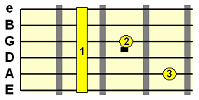 |
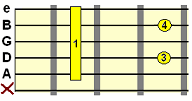 |
You can also use a dominant 7th chord to "destabalise" the tonic before resolving to the IV chord. Here's an example...
Click to hear
I
- A
major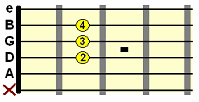 |
I7
- A7
(A dominant 7)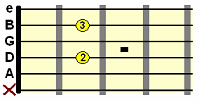 |
IV
- D
major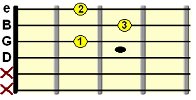 |
iv
- D
minor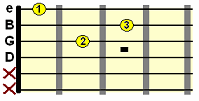 |
You'll notice I also turned that major IV into a minor iv, which is one of the variations we looked at for the IV chord.
There are also extentions of these dominant 7th chords which are most commonly used in jazz and blues.
One of my favourites is the dominant 9th chord (e.g. C9)...

Or a 13th chord (e.g. C13) - a very "full" sounding chord (note: the fingering is a bit more awkward for this one, as you need to barre both your index and 4th finger)...

Remember, as these are dominant 7th chords, they can also be used in the V position, as we learned in past lessons that the 5 chord is naturally enhanced by using dominant 7th chords (hence why this 5th degree chord is called the dominant!).
More specifically on "jazzy" chords in another lesson.
Added note tonic chords
Added tone chords don't use the 7th like in the examples above, so these provide more neutral major chord flavours for your tonic. It's always good to add some colour to those basic major/minor triads.A couple of A string root shapes...
Added 6th
chord (e.g. Cadd6)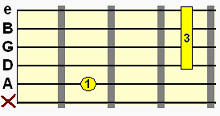 |
Added
6th/9th chord (e.g. Cadd6/9)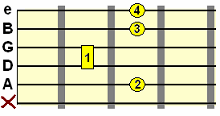 |
Don't forget the open position added chords which can sound great as tonic chords.
Suspended tonics
I often like to use suspended 2nd chords because they provide a more neutral sound that you can dress with lead harmonies quite freely. For tonic chords rooted on the A string...
You could also use suspended 4th (sus4) chords in the tonic position, however, these chords perhaps sound too unresolved on their own and are most often resolved to a major chord in the same position, or at least interchanged with a regular major tonic, like below...
Click to hear
I
- E
major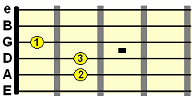 |
I -
Esus4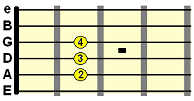 |
More on using the major tonic as an ending chord...
The tonic as the ending chord
When we talk about "resolution" we are simply talking about the ending of a musical phrase within a song. The tonic is often used as the ending chord to reaffirm that return home for the last time.As a result, it's common to "big up" that final tonic chord by extending the major chord and perhaps playing it in a different way so it sounds more vibrant. One way to attain this is to use open chords (chords which use open strings) to give the song more of a grand and conclusive finish. Simply play around with the basic chord shapes you know and see if you can beef up that ending chord.
For example, a really lush open Eadd9 chord can be built simply by adding our 4th finger to the D string at the 4th fret...

Listen to any classical or jazz piece and you'll hear how the ending tonic is milked for all its worth! This tradition carried right through into rock and pop, and for songs that don't simply fade out, the bigged up tonic is a popular choice for concluding the song.
However, there are also certain tensions you can add to that tonic chord to give it a more unorthodox, unpredictable or even unsettled conclusion to your song.
For example, this jazzy flat 5th chord provides us with a rather unsettling and confused ending...

To me, that says "is this really the end...?"
Then there's the "big" blues ending, which uses the dominant 7th from earlier, but with an added #9, often referred to as the "Hendrix chord" because it was (apparently) popularised by Jimi Hendrix...

Here's the thing - from the past lessons on building the diatonic scale, you should know the root note positions. It's now up to you to experiment with the different chords you can build on these root notes. Explore the chord section for ideas.
Of course, sometimes simply using that basic major barre/open chord will worj well for your song, but having these creative options gives you the variation you need, from one song to the next.
| |
Tweet |
Stay updated and learn more
Sign up to the newsletter for updates and grab your free Uncommon Chords book
Sign up to the newsletter for updates and grab your free Uncommon Chords book
Main Guitar Chord Progressions Section








